Top Homeschooling Trends in India I 2025
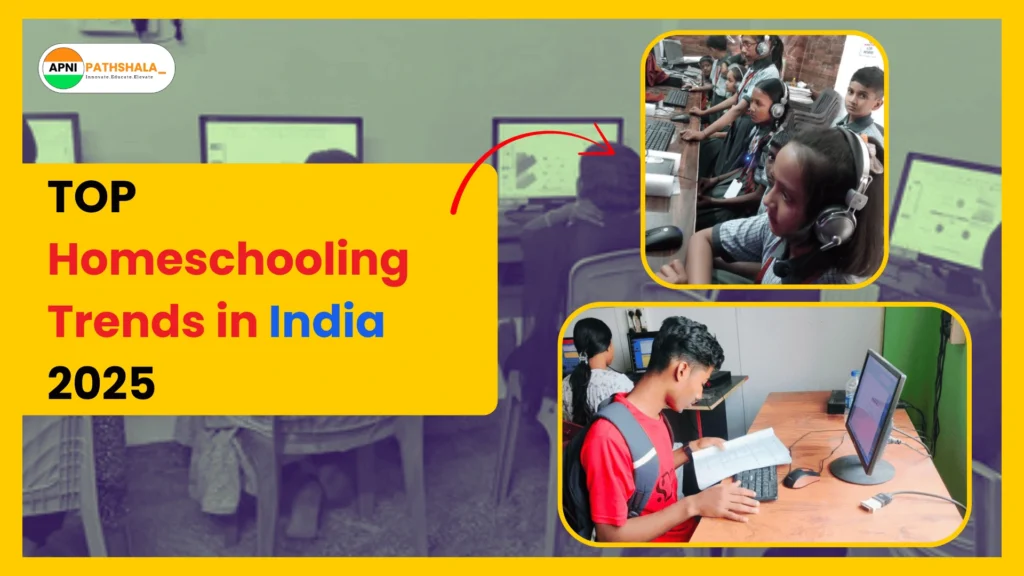
A quick question for you. When you hear the word “homeschooling,” do you still picture kids sitting at the dining table with a pile of books while parents try to be teachers? Well, things have changed. A lot. In 2025, homeschooling is not just about staying at home. It’s about using smart tools like AI, and learning in a way that actually suits your child and not the other way around. Kids are learning at their own speed, choosing topics they enjoy, and getting help from technology that understands what they need. It’s like having a personal classroom that’s built just for them. If you’re a parent thinking about homeschooling, already doing it, or just curious about what’s new, this blog is for you. Let’s look at what’s trending in homeschooling right now, and how you can make the most of it for your child. 1. Artificial Intelligence in Homeschooling You’ve probably heard the word “AI” so many times, it feels like the most overhyped word. But when it comes to homeschooling, AI is not hype, it’s help. And it’s changing how Indian children learn at home. How is AI being used in homeschooling? Instead of giving your child the same worksheet as every other kid, AI lets them learn at their own pace, in their own way. It’s not about replacing parents or teachers. It’s about supporting them, so the learning feels personal and progress is clear. Why do parents love this? 2. Mobile-First Learning Here’s the truth: Not every homeschooling family in India can afford laptops, fancy setups, or high-speed Wi-Fi. But, this does not have to be a roadblock in a child’s education. This is because from rural India to the urban one, almost everyone has a smartphone. Plus, there are a lot of government initiatives where smartphones are regularly distributed to the needy ones. And in 2025, that’s enough. How can you use it? Whether you’re in Delhi or a small town anywhere else, your child can now access quality content using just a smartphone. And parents are loving this shift because it’s: Mobile-first learning is a big reason why homeschooling is becoming more practical across India, not just for the elite. 3. Personalized Learning Plans This isn’t about using high-end tech. This is about changing how we think about learning. Today, more Indian parents are ditching “fixed” timetables and standard textbooks in favor of personalised learning, because every child learns differently. What does this look like? Let’s say your child is strong in math but struggles with writing. You don’t need to spend equal time on both. Focus more on writing, and let them move faster in math. That’s the beauty of personalised learning, it’s efficient and child-focused. How are parents doing it? In short, you become the architect of your child’s education. And it works. Want a testimonial? 4. Hybrid Homeschooling Full-time homeschooling is a big step. Some parents want flexibility, but also the structure of school. That’s where hybrid homeschooling is becoming popular in Indian cities. What is Hybrid Homeschooling? Hybrid homeschooling is a flexible approach that blends the structure of traditional schooling with the freedom of homeschooling. Instead of choosing between full-time school or full-time homeschool, you can do both on your own terms. Here’s how hybrid homeschooling works in 2025: Why are Indian families loving hybrid homeschooling? Many schools are even open to flexible attendance now, especially after COVID. Parents all over are creating hybrid learning schedules that balance academics, hobbies, and emotional health. And the results? Children are more relaxed, more focused, and more curious. Read this story of Lakshya, a seven year old who builds robots and is getting homeschooled by his father. 5. Community-Based Microschools This is one of the most heartwarming homeschooling trends in 2025. Instead of sending kids to a big school, families in the same apartment, neighbourhood, or society are starting microschools. Think of it as a mini school run by parents and local facilitators. What does a microschool look like? Imagine 5 to 15 kids of different age groups, learning together like in a big joint family. There are no rigid time tables or heavy textbooks. Learning happens through hands-on activities, meaningful discussions, curiosity-led projects, and real-life experiences. Often, these kids are taught not by certified teachers, but by parents, freelancers, retired educators, or even college students who are passionate about a subject. Some bring in local artists or science communicators. Others take kids on field visits to farms, libraries, or even nearby construction sites to understand how the real world works. Why is this trend catching on in 2025? If you’re exploring homeschooling in 2025, just know, you’re not the only one figuring it out. From AI tools to small learning pods, families across India are rewriting the rules. It’s not always easy. But it’s real. It’s personal. And it’s working. At ApniPathshala, we’re walking this journey with you. We help learning pods get the basics like personal PCs and guidance, so kids can actually thrive, not just study. If you’re starting something, or even thinking about it, we’d love to help.
FAQS On Homeschooling in India 2025
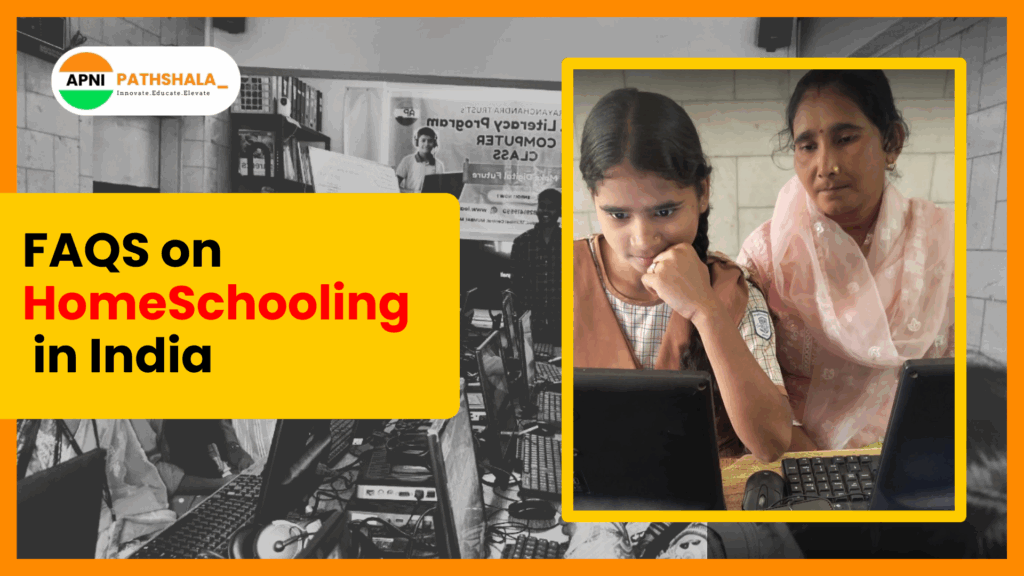
Is school really the only way to educate a child in India?Short answer: No.Better answer: Welcome to homeschooling in India, where learning actually makes sense. If you’re tired of this rat race for marks, and the overall education system that doesn’t even make any sense in big 2025, Homeschooling is the option for you. Thousands of parents across India are now understanding this concept and choosing freedom and real learning for their kids. And guess what? You don’t need a fancy degree, an expensive setup, or someone’s approval to homeschool. All you need is the right information, and that’s exactly what you’ll find here. Ready? 1. What is homeschooling, and how is it different from regular schooling? Homeschooling means teaching your child at home instead of sending them to a traditional school. It doesn’t mean you sit for 6 hours with textbooks. It means: No uniforms. No exams for the sake of exams. Just actual learning. 2. Is homeschooling legal in India? Short answer: Yes. But let’s break it down. There’s no law in India that says homeschooling is illegal. The Right to Education Act (RTE) says every child has the right to education, but it doesn’t say schooling is the only way. In fact, multiple High Court judgments (including Delhi and Tamil Nadu) have recognized the right of parents to homeschool. So yes, you can legally homeschool in India in 2025 without worrying about court cases or jail time. You don’t need: You just need a genuine intent to educate your child well. 3. Can I homeschool under CBSE or ICSE? CBSE and ICSE currently do not allow private candidates (unless through NIOS or state boards). But here’s the trick: you can: 4. Do Indian colleges accept homeschooled students? 100%, yes. Colleges care about your board certificate, not where you studied. If your child clears 12th via NIOS or IGCSE, they’re eligible for: A lot of students who cracked top exams in recent years had alternative education backgrounds, some even unschooled till 10th. So no, homeschooling won’t “spoil” your child’s future. If anything, it might unlock it. 5. How do I start homeschooling in India? Starting homeschooling in India can feel like a big decision, but taking it step by step will make it much easier. Here’s how you can get started: 6. Do I need to register somewhere for homeschooling? No. There’s no formal registration required for homeschooling in India (as of 2025). But keep records of your child’s learning journey, just in case you need it later for exams or transitions. 7. How Much Does Homeschooling in India Cost? Let’s be very clear: Homeschooling does not mean expensive international schools. You can homeschool in India for as low as ₹3000/month, or go as high as ₹30,000/month depending on your style. Here’s a quick cost table: Style Monthly Cost (Approx) Includes Budget ₹2,000–₹5,000 NCERT books, free apps, DIY worksheets Balanced ₹5,000–₹10,000 Live online classes, tutors, and paid apps Premium ₹15,000–₹30,000+ International curriculum, mentors, pods Homeschooling lets you control the budget, unlike fixed private school fees. 8. Do I have to be a trained teacher to homeschool? Not at all. You just need patience, curiosity, and a willingness to learn with your child. Use online resources and community support to guide your journey. 9. What are the benefits of homeschooling in India? 10. What are the challenges of homeschooling in India? 11. Can my child go back to regular school later? Yes. Schools may ask for an entrance test or interview. Just keep records of your child’s learning. 12. Are there support groups for homeschoolers in India? Absolutely. Look for: Final Thoughts: Homeschooling isn’t just an educational method. It’s a mindset shift. You don’t need to be perfect. You just need to care. Start with free community classes, attend a few homeschooling meetups, or download a weekly planner.Read success stories and explore options at Apni Pathshala: one of India’s most trusted learning communities.Your child deserves a life of curiosity, confidence, and freedom.And you have the power to give it to them.
Don’t send your kids to traditional schools
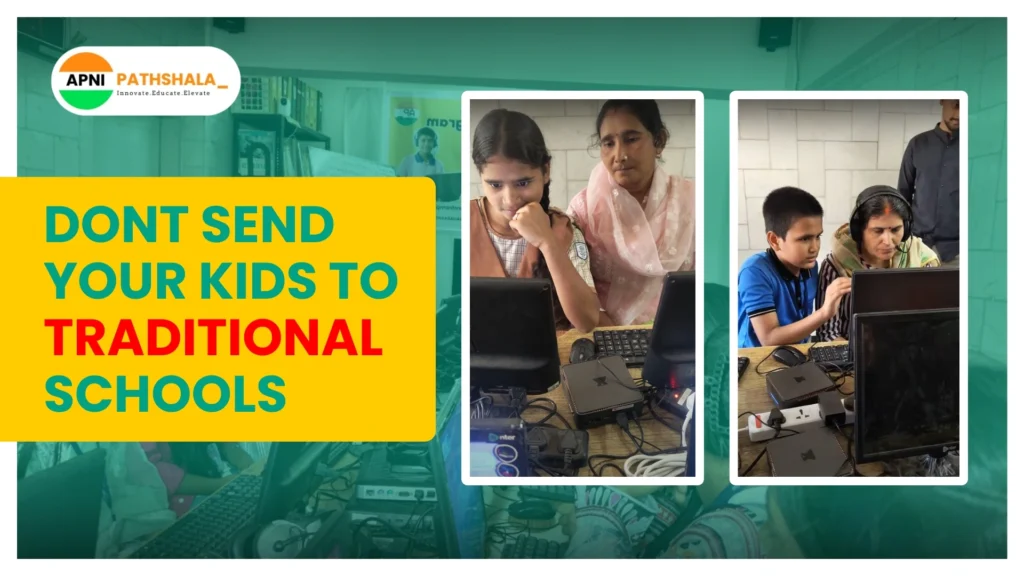
Are you sure traditional schooling is the best for your child? Let’s be honest. How many times have you seen your child come home from school looking exhausted, uninspired, and just… done? How often do they memorize things for exams, only to forget them the next day? How many of their days are spent following rigid schedules that leave zero room for creativity or actual learning? If this feels relatable, you need to ask yourself—is traditional schooling really working for your child? The truth is, most schools aren’t designed for real learning. They’re designed for control. They reward obedience, punish curiosity, and prioritize grades over actual understanding. But there’s a better way. Why are traditional schools failing your child? 1. Schools Kill Creativity & Curiosity Kids are born curious. They ask a million questions. They explore. They experiment. But what happens when they enter school? They’re told to sit down, be quiet, and follow instructions. 2. The Education System Prepares Kids for a World That No Longer Exists Let’s be real, schools were designed for the industrial era. They were meant to produce factory workers who followed orders. But today, we live in the age of AI, automation, and remote work. So why are we still relying solely on traditional school for our kids? 3. Schools Are a Breeding Ground for Stress, Anxiety & Peer Pressure Remember your own school days? The constant pressure to score well, fit in, and not make mistakes? Today, it’s even worse. And the worst part? Most parents see this happening but feel helpless to change it. But what if you had another option? The Alternative: Real Learning Without Traditional School We can’t just talk about the problem without giving you a solution. If traditional schools don’t work, then what’s the better alternative? The answer lies in self-directed learning, homeschooling, microschools, and alternative education models that allow children to learn in a way that actually makes sense for them. At their own pace, based on their interests, and without the unnecessary stress of school. 1. Homeschooled Kids Learn Faster & Better In traditional schools, students spend an average of 6–8 hours per day in classrooms. But have you ever thought about how much of that time is actually spent learning? Why do homeschooled kids learn faster? Do homeschooled kids perform well academically? Absolutely! Studies show that homeschooled students: 2. They Develop Real-World Skills, Not Just Theories Let’s be honest—how much of what we learned in school do we actually use in real life?Schools spend years teaching trigonometry and Shakespeare, but ignore financial literacy, entrepreneurship, communication skills, and problem-solving. Alternative education fixes this. Instead of just memorizing theory, kids learn practical skills they can use in the real world. What kind of skills? Many teenagers today are self-taught programmers working on real-world projects while school kids are still stuck writing textbook answers. Now, think about this—why should your child spend years studying things they’ll never use when they could be mastering the skills that will actually shape their future? 3. They Are Happier and Mentally Healthier School is supposed to be about learning. But for many kids, it’s a source of stress, pressure, and anxiety. What happens when kids escape this system? Now, tell me—what’s more important? A report card filled with forced grades or a mentally strong, confident child ready to face the world? How to Get Started With Alternative Education? Thinking, “This sounds great, but how do I start?” Don’t worry, here’s a step-by-step guide. Step 1: Explore Different Education Models You don’t have to follow one rigid system. Choose what works best for your child. Step 2: Find a Support System Step 3: Use the Right Resources Step 4: Start Small Final Thoughts: The Future of Learning is Here As already mentioned above, traditional schools were designed for the industrial age, not for the future. If you truly want your child to be prepared for the real world, then thinking beyond traditional schools is not just an option—it’s a necessity. Start today. Explore alternative education. Give your child the learning experience they truly deserve.Want to explore self-directed learning?Check out Apni Pathshala—India’s leading platform for homeschooling, unschooling, and alternative education.
The ultimate guide to homeschooling: Apps, Websites, and Tools
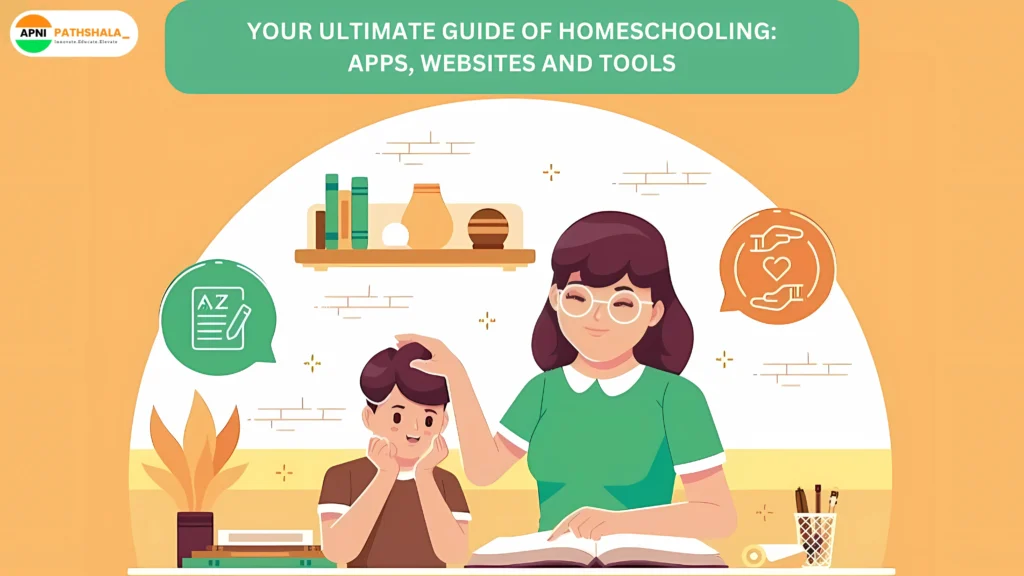
Homeschooling Was Supposed to Be Easier, Right? “Am I doing this right?” If you’re a homeschooling parent, you’ve probably had this thought at some point. Homeschooling sounds amazing in theory—personalized learning, flexible schedules, no school stress. But in reality? It can be overwhelming. If these thoughts have ever crossed your mind, you’re not alone. Every homeschooling parent faces these struggles. But here’s the good news: You don’t have to do this alone. The right apps, websites, and tools can make homeschooling structured, fun, and effective for both you and your child. Instead of spending hours planning, worrying, or second-guessing, you can focus on what truly matters: helping your child love learning. This guide will mention the best homeschooling resources to help you plan, teach, track progress, and stay organized. Why Do You Need the Right Tools for Homeschooling? Trying homeschooling without a proper schedule and resources will 110% make you frustrated. You’ll end up wasting time, and probably end up with a mess. The best homeschooling tools can: Now, let’s get into the best homeschooling tools you should use. Best Apps for Homeschooling 1. Learning Apps (To Make Studying Fun & Interactive) Khan Academy (Free) – Think of it as a personal tutor, but without fees. Whether your child is doing multiplication or calculus, Khan Academy offers structured lessons with video explanations and interactive exercises. It’s a must-have for students of all ages. Duolingo (Free) – If your child dreams of speaking Spanish, Japanese, or even Klingon (yes, really!), Duolingo makes it happen. It turns language learning into a game with levels, rewards, and AI-powered personalized lessons. Scratch (Free) –Designed by MIT, this app introduces kids to coding in the most fun way possible—by letting them create their own animations and games. No complicated syntax, just drag-and-drop coding blocks to bring ideas to life. Prodigy Math (Free) – Math doesn’t have to be boring! Prodigy transforms equations into an adventure, using role-playing elements to keep kids engaged while they solve math problems. Best suited for grades 1-8. BrainPOP – If your child prefers watching over reading, BrainPOP is a game-changer. It delivers short, animated lessons on a variety of subjects, paired with interactive quizzes to reinforce learning. 2. Planning & Organization Apps (For Parents) Homeschool Panda –This app is like a personal assistant for homeschooling. It helps you plan lessons, track schedules, and even manage your homeschool budget. Everything you need is in one place, making it easier to stay on top of things. Trello – Next we have Trello. It is perfect for keeping track of tasks. You can create boards for different subjects, assignments, and goals, then move them around as you make progress. It’s simple, and visual, and really helps you stay organized. Google Keep – Google Keep is a lifesaver for quick notes and ideas. You can write down lesson plans or reminders, and it syncs across all your devices. It’s easy to use, and the color coding and voice notes make organizing simple. Evernote – Evernote is great for keeping all your lesson plans, to-do lists, and notes in one place. You can clip web pages, save PDFs, and easily search through everything when you need it. It’s a one-stop shop for staying organized. There are sooo many options, you can go with anyone you find comfortable! 3. Assessment & Quiz Apps (To Track Learning) Want to see how well your child is doing? These apps make assessments easy and even fun. Quizlet – This app lets you create flashcards and quizzes to reinforce learning. You can create your own or use pre-made study sets for subjects your child is working on. The app also uses AI to help them retain what they’ve learned. Google Forms – There’s a google app for everything! Google Forms lets you create custom quizzes and surveys, then automatically generates reports. It’s a simple way to track progress and give feedback. IXL Learning – IXL adapts to your child’s learning level and gives them instant feedback. It covers math, language arts, science, and more, so your child can improve at their own pace. Kahoot! – Kahoot! turns quizzes into a game. You can create your own questions, and your child can answer in a fun, interactive way. It’s a great way to make learning and assessment feel like a competition. Best Websites for Homeschooling 1. Full Curriculum Resources If you’re looking for a complete, structured curriculum, these websites have got you covered: NCERT e-Pathshala – The National Council of Educational Research and Training (NCERT) offers free digital textbooks and learning resources aligned with CBSE and state board syllabi. Diksha – The Government of India’s digital learning initiative provides high-quality interactive content in multiple Indian languages, covering NCERT and state board topics. BeyondExams – A fantastic open-learning platform that encourages self-paced learning, allowing students to explore subjects beyond traditional school curriculums. TopperLearning – Offers CBSE, ICSE, and state board-aligned learning materials, video lessons, and interactive quizzes. BYJU’S – One of India’s most well-known ed-tech platforms, offering engaging, video-based lessons for CBSE, ICSE, and state boards. 2. Interactive Learning Websites Kids love to learn when it’s hands-on and fun. These interactive websites make learning exciting and help your child get involved in the process: National Geographic Kids – This site makes science, geography, and history come to life with fun, visual-based lessons and games. It’s a great way for your child to explore the world around them. Mystery Science – If your child loves science experiments, Mystery Science provides hands-on lessons that are both educational and exciting. TypingClub – TypingClub helps your child develop typing skills through fun, interactive exercises. It’s a great way to boost their computer skills. PBS Kids – PBS Kids offers a wide range of educational videos and interactive games that make learning fun for younger children. Tools to Make Homeschooling Easier 1. Communication & Collaboration Tools Clear communication is key to keeping everything on track. These tools can help you stay connected and organized: Zoom –
School failed this kid. But his Dad made his dream come true!
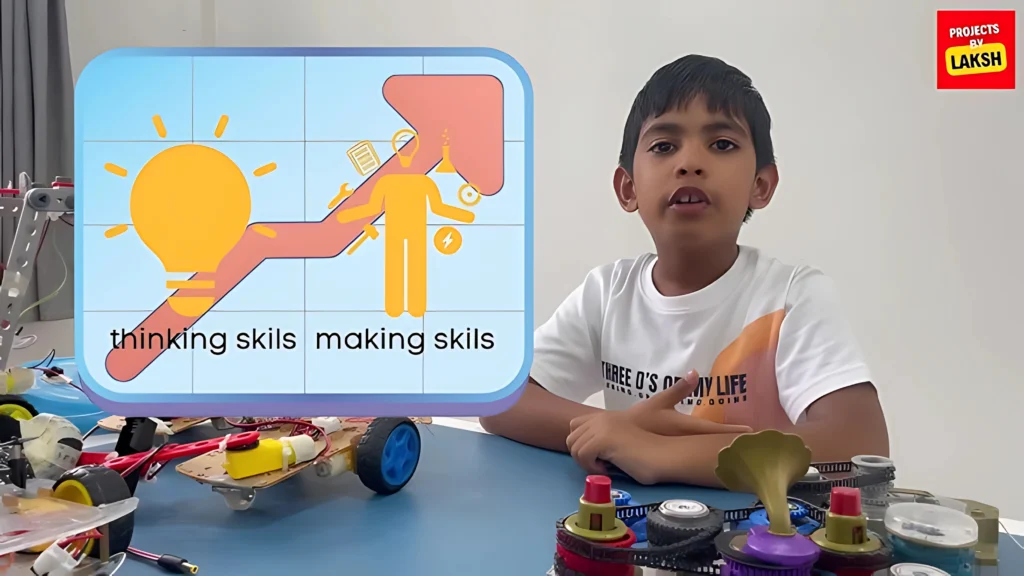
(Narrated by Venkat) Let me ask you something. When was the last time your child did something so amazing, so unexpected, that it filled you with pride and joy, making you think, “Wowwww, he is doing something beyond his regular curriculum?” For me, that moment came a year ago when Lakshveer, my 6-year-old, said, “Papa, I want to build robots.” At first, I laughed. I mean, what kind of 7-year-old says something like that? But then I saw the seriousness in his eyes. This wasn’t just “kid talk.” He meant it. He was curious—hungry to learn and I knew I couldn’t let this moment slip away. Fast forward to today, Lakshveer is not just building robots. He’s writing blogs, creating websites, developing games, and learning the kind of electronics that most adults find intimidating. The surprising part? He still goes to regular school. But if you ask me, the real learning—the stuff that makes his soul happy happens right here at home. How Homeschooling Supports Big Dreams Let me be very clear here, I’m not here to deny the importance of traditional schooling. It has its own pace. Lakshveer goes to school like any other kid, learns his subjects, and comes home. But here’s the thing—school doesn’t teach passion. No one at school was talking about robotics, game development, or how circuits work. And honestly, why would they? It’s not part of the curriculum. But here’s where I had to make a choice: I could either rely on the system and hope it somehow addressed his interests, or I could step up and fill the gap myself. The answer was obvious.🤷🏻♂️ Even Parents Have to Learn I still remember the day it all started. I brought home a simple robotics kit for Lakshveer. My plan? Keep him busy for a few hours so I can finish my work. But instead of getting bored, he got really excited. He asked me questions I couldn’t answer: I didn’t know the answers. But I knew one thing – I wanted to find those answers for my son. Learning Together: A Parent’s Journey Before Lakshveer, I was not a tech-savvy person. Honestly, I didn’t know much about electronics or robotics. But when your child shows that kind of passion, you don’t just sit back and watch. We started small: watching YouTube tutorials, reading beginner guides, and experimenting with basic circuits. Our living room soon turned into a robotics lab, and I found myself learning right alongside him. And you know what? It wasn’t just the kid who was growing. I was growing too–both as a parent and as a person. There’s No Such Thing as Balance–You Have to Choose Let me tell you something I’ve learned along the way–there’s nothing called “balance.” Balance is a myth. You have to make choices, and those choices come down to priorities. For us, it was simple: Lakshveer’s passion came first. Yes, school was important for foundational learning, but when it came to his love for robotics, we had to go all in. My wife focused on his academics, while I dedicated my time to exploring his interests with him. And let me be clear, it wasn’t always easy. There were times I felt really overwhelmed, wondering if we were doing enough or if we were going too far. But we learned something crucial: when you focus on what truly matters, everything else falls into place. It’s messy, it’s imperfect but it’s real! Sharing Our Story with the World One day, I decided to share our journey on Twitter. I thought, Why not document what we’re doing? I shared things like his first robot, his early attempts at coding, his workshops. And to my surprise, the response was overwhelming. Parents started reaching out: These responses gave me an idea: why not create a community for parents like us? A place where homeschooling parents could connect, share ideas, and learn from each other. Building a Community of Dreamers That’s how our small homeschooling journey turned into something much bigger. With support from like-minded people (special shoutout to Aniruddha Malpani!), we’ve built a close-knit community of parents who share ideas, resources, and inspiration. Even parents who follow traditional schooling methods appreciate what we’re doing. They’ve told me, “You’re doing something different, something we couldn’t even imagine.” We shared ideas, supported each other, and learned together. And over time, I realized something profound that this wasn’t just about Lakshveer anymore. It was about other kids and parents discovering their own unique paths as well. Turning Passion into Something Sustainable While Lakshveer’s learning journey has been exciting, I often wondered: How can we make this sustainable? That’s when we started co-creating products. Like this business model that helps my kid learn while also teaching others. For example, Lakshveer developed a game that got amazing feedback online. We’re now scaling it up, turning it into something bigger. The goal is simple: to create opportunities where learning and entrepreneurship go hand in hand. It’s not easy, but it’s worth it. Lessons Every Parent Should Know If there’s one thing I’ve learned, it’s that every child has a superpower. Our job as parents is to help them find it. Here are a few lessons I’ve learned along the way: What’s Next? Lakshveer’s journey is just beginning. Every day, we’re learning something new—about robotics, about parenting, and about each other. If you’re a parent reading this, wondering if you’re doing enough for your child, let me tell you this: you are. You don’t need to have all the answers. You just need to show up, listen, and be willing to learn. Because at the end of the day, parenting isn’t about being perfect. It’s about being present. So take that first step. Ask your child what excites them. Watch where their curiosity leads. And who knows? You might just uncover something extraordinary. At ApniPathshala, we’re all about empowering parents and children to explore, learn, and grow together. If you’re looking to be part of a community that’s focused on real learning and real connection, contact us and start your journey today.
7 Popular Alternative Education Models | Benefits & Insights
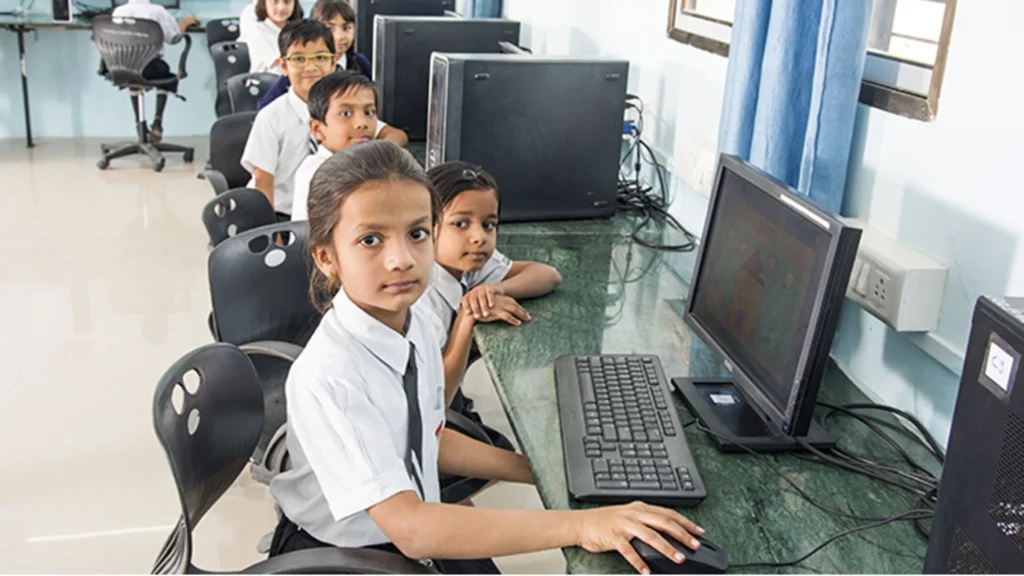
Education is evolving. Children are no more interested in sitting 8-9 hours in a four walled room and studying. With the arrival of technology and access to smart devices (thanks to covid), traditional classrooms have become increasingly less effective for many students. So, the next best option- alternative education models are gaining popularity. These methods allow children to explore their interests, learn at their own pace, and develop skills that prepare them for a changing world. As the name suggests, I’m sure you must have a fair idea of what alternative education is. But, what about the different models? In this blog, we will explore some of the most popular types of alternative education today, explaining their principles and why they might be the right fit for your child. 1. Montessori Education First we have Montessori education. Developed by Dr. Maria Montessori in the early 1900s, it’s one of the most well-known and established forms of alternative education. This approach prioritizes a child’s natural curiosity and promotes self-directed learning. In a Montessori classroom, students are free to choose their activities, which encourages independence, problem-solving, and creativity. What are the benefits of Montessori Education? Montessori schools are present worldwide, from preschools to high schools, and are a popular choice for parents who value flexibility and a personalized education. 2. Waldorf Education Founded by Rudolf Steiner in 1919, Waldorf education aims to educate the whole child—intellectually, emotionally, and physically. Waldorf schools focus on integrating academic subjects with creative arts like music and painting. The goal is to nurture the development of each student, helping them grow into well-rounded individuals. What are the benefits of Waldorf Education? This approach is ideal for families who believe in developing emotional intelligence, creativity, and a deeper connection with nature and the world around them. 3. Reggio Emilia Approach The Reggio Emilia approach originated in Italy after World War II and is centered on the idea that children are competent learners capable of building their own knowledge. In this model, children are encouraged to explore their interests through projects and inquiry-based learning This makes them active participants in their educational journey. What are the benefits of Reggio Emilia Approach? Reggio Emilia has gained international stature, with schools adopting its principles around the world, from the United States to Australia. 4. Homeschooling Homeschooling is one of the most flexible forms of alternative education. Talking about statistics, the number of homeschooled students in India ranges between 500 000 and 2.7 million. And, that is huge! Parents take on the responsibility of teaching their children at home, allowing them to design the curriculum to suit the child’s individual learning style, interests, and pace. This model offers unparalleled freedom and the ability to adapt the educational experience to fit the child’s needs. What are the benefits of Homeschooling? As homeschooling grows in popularity, especially after the global pandemic, it has become an accessible option for many families who want to take a more hands-on approach to education. 5. Online Learning Next we have the most popular form of alternative education- Online Learning. It might be a scary phrase for some of the parents out there, but it is what it is! The rise of technology has made online learning an increasingly viable option for students worldwide. Online education offers the flexibility of learning from home or anywhere with an internet connection. It includes both formal online schools and informal learning platforms offering specific courses or subjects. What are the benefits of Online Learning? Online learning continues to grow, providing an invaluable option for students who need more flexibility or live in remote areas without easy access to traditional schools. 6. Microschools Microschools are small, independent schools that provide personalized education in a community setting. These schools are typically made up of fewer than 150 students and focus on fostering strong relationships between teachers and students. The approach is highly adaptable, allowing for small group instruction and a focus on individual learning needs. What are the benefits of Microschools? Not talking about ApniPathshala while discussing microschools won’t be a right thing to do. This organisation offers a unique approach to education, closely aligned with the principles of microschools. ApniPathshala empowers both parents and students with the flexibility to create a perfect and personalized educational experience. Whether you’re looking for homeschooling options, online resources, or community-driven educational tools, ApniPathshala ensures that every child has the support they need to succeed in their educational journey. If you want to be a part of the journey of providing quality education to kids in every corner, contact ApniPathshala straight away! 7. Project-Based Learning Last but not the least, we have Project-based learning (PBL). It is an educational approach where students work on a project over an extended period, learning about a subject in-depth while solving real-world problems. This practical, student-driven approach encourages critical thinking, collaboration, and creativity. What are the benefits of Project- Based Learning? As educational systems evolve, alternative learning models provide a variety of options for parents and students seeking a more personalized and holistic approach to learning. From Montessori’s self-directed approach to online learning, these alternative educational models cater to diverse learning styles. This overall helps students work and grow in environments that suit their individual needs. Whether you’re looking for an arts-based approach, flexible learning, or learning in small groups, alternative education provides a range of options to help children reach their full potential. As these models continue to grow in popularity, the future of education looks brighter, more inclusive, and adaptable than ever before. If you wanna be a part of a journey that constantly works for the betterment of kids- urban and rural, join hands with ApniPathshala. Let’s make a change together!
What Is Alternative Education? A Beginner’s Guide
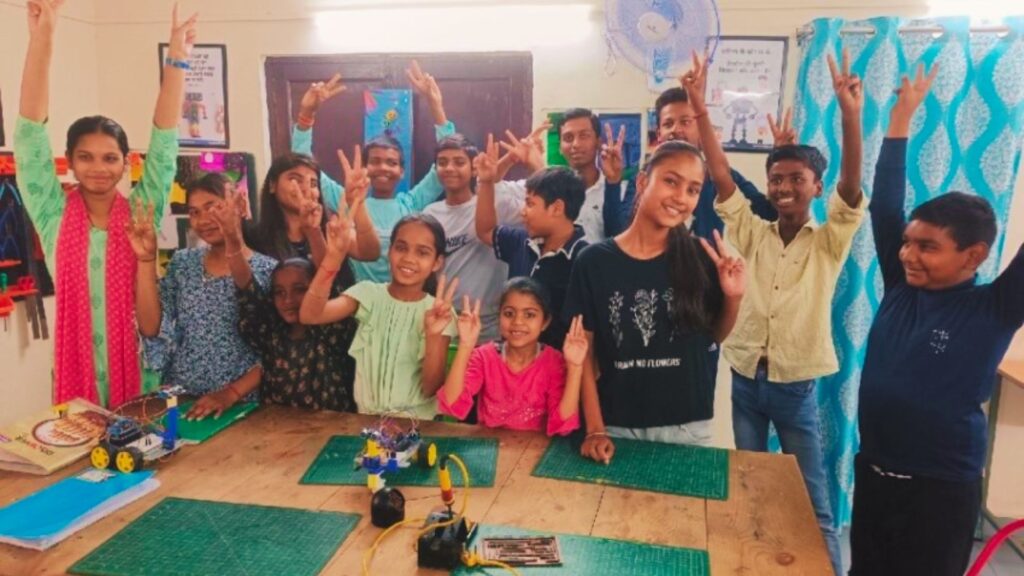
What comes to your mind when you hear of alternative education? An alternative to education? No, but you’re quite close to the answer- it means an alternative approach to education! In a world where traditional education systems often follow rigid frameworks, alternative education offers a refreshing approach. Based on the foundation of flexibility and creativity, this model addresses the diverse needs of learners and emphasizes personalized growth over standardized outcomes. If you’re curious about what alternative education is, its types and other aspects- you are at the right place! What is Alternative Education? Alternative education is a different approach to learning that is completely different from the typical methods used in traditional schools. Instead of sticking to rigid rules and standard curriculums, alternative education creates space for more flexible and creative ways of teaching. It’s especially helpful for students who might struggle in conventional school settings or those who simply want a learning experience that suits their unique needs. Key Characteristics of Alternative Education Types of Alternative Education Models a. Montessori Schools Montessori schools focus on letting kids take charge of their own learning. Instead of teachers dictating every step, children explore and learn at their own pace with practical activities. Montessori schools encourage independence and curiosity, helping children grow into confident learners. b. Waldorf Education If creativity is your child’s main focus area, Waldorf schools could be a perfect fit. This model mixes academics with artistic and imaginative activities to nurture the whole child. Waldorf education aims to create well-rounded individuals with strong imaginative and critical-thinking skills. c. Homeschooling Homeschooling, as the name suggests- allows parents to handle the education of their child themselves. This offers a personalized experience that adapts to the kid’s pace and interests. Homeschooling is ideal for families seeking flexibility and personalized education paths. d. Forest Schools Imagine a school amidst a forest! Sounds exciting, right? Forest schools focus on outdoor learning, helping kids connect with the environment while building practical skills. Forest schools are perfect for children who work well in open and adventurous settings. e. Online Schools The most famous form of teaching- thanks to covid19! Technology has made education accessible anywhere, anytime. Online schools offer students the flexibility to learn without being tied to a physical location. Online schools are great for families who want convenience without compromising quality education. Who Benefits from Alternative Education? So, till now it is clear that alternative education isn’t just another way of learning. It’s a lifeline for many who don’t fit into the traditional schooling mold. Now let’s move on and see who can benefit the most in these environments: 1. Creative Thinkers For kids who just flash their brightest of smiles when given the freedom to explore, alternative education is a perfect match. These are the dreamers, problem-solvers, and innovators who work excellently in unstructured or practical settings. Traditional classrooms may curb their creativity, but alternative models give them the space to think outside the box. 2. Neurodivergent Students Children with ADHD, autism, or dyslexia often face challenges in conventional classrooms, where the normal teaching doesn’t address their unique needs. Alternative education offers personalized approaches, smaller class sizes, and empathetic teachers who focus on their strengths. 3. At-Risk Youth Some students struggle in mainstream schools due to personal or social challenges like bullying, anxiety, or unstable home environments. Alternative education provides a supportive, inclusive atmosphere where they can rebuild confidence and rediscover the joy of learning. 4. Families Seeking Values-Based Education Many parents want an education that aligns with their religious, ethical, or cultural beliefs. Alternative education allows families to integrate these values into their child’s learning experience, ensuring that the education feels both personal and meaningful. Challenges of Alternative Education There are two sides of a coin. As promising as it is, alternative education isn’t without its challenges: Alternative Education in India: The Role of Apni Pathshala In India, where traditional route learning often takes center stage, organizations like Apni Pathshala are breaking the generational cycles. They’re proving that education can be creative, inclusive, and deeply impactful. What Makes Apni Pathshala Different? If you want to know more about Anipathshala’s work or want to start an alternative education pod- contact us! How to Choose the Right Alternative Education Path? If you’re thinking of taking the alternative way, here are some tips to make the best choice: FAQs on Alternative Education Q: Is alternative education suitable for all students? A: While highly beneficial for many, it depends on individual needs and learning styles. Q: Do alternative education schools follow a curriculum? A: Most follow a flexible curriculum, often aligning loosely with national standards. Q: Can students from alternative schools join mainstream colleges? A: Yes, many alternative education systems equip students with skills and certifications recognized globally.
How can learning pods support homeschooling families?

Homeschooling is no longer just a concept from western sitcoms. Thanks to covid, it has become more popular than ever. But how are learning pods related to this idea? Well, learning pods are now the top choices for homeschooling families. These pods provide a middle ground between traditional schooling and homeschooling, offering a community for children and support for parents. If you want to know more about how learning pods enhance the overall experience of homeschooling making education more flexible and enriching, here is something really useful for you. What Are Learning Pods? Learning pods are small learning groups where kids with similar learning goals come together. These groups are usually guided by either a teacher or a knowledgeable parent, offering a flexible and personalised learning experience that matches the students’ levels. Learning pods became popular during the COVID-19 pandemic as a way to help families manage remote learning and provide support for parents. Families usually see these pods as a better social approach to homeschooling and education.Now, let’s now explore the core part of this article- What are the benefits of Learning pods for homeschooling families? Benefits of Learning Pods for Homeschooling Families 1. Personalised Attention and CurriculumFirst and the most important benefit of learning pods is their adaptability to each child’s individual pace and interests. Unlike large classrooms with strict curriculum requirements, learning pods allow parents or educators to modify lessons based on the group’s needs. This flexible approach aligns well with homeschooling, where personalised learning is given the utmost importance. In a learning pod, children who need extra help in specific areas can receive it without impacting others, while children excelling in certain subjects can be encouraged to explore further. 2. Socialisation in a Safe SpaceOne of the biggest concerns with homeschooling is that kids may miss out on chances to socialise with peers. Learning pods solve this by bringing together students of similar ages and learning levels, creating a small, friendly community. Here, children can learn to work in teams, and build essential social skills. Learning pods support kids’ emotional growth by helping them develop empathy and cooperation. This setup can be especially valuable in situations like remote learning or during health concerns like COVID, when typical school settings aren’t as accessible. 3. Structured Learning with FlexibilityMoving ahead, we know that homeschooling offers great flexibility, but without a set structure. Families may find it quite hard to keep up with regular learning progress. Learning pods bring an organised routine with set schedules and goals, while still allowing for the flexibility homeschooling families love. Parents can plan meeting times, activities, and learning goals to ensure the pod supports their homeschool journey. Plus, learning pods make it easy to add in fun extras like field trips, outdoor learning, or art projects. 4. Support for ParentsHomeschooling often means parents take on the roles of teacher, planner, and more, which can be overwhelming. Learning pods help share the load by splitting responsibilities among several parents or bringing in a tutor to lead lessons. This setup eases the pressure on parents, letting them manage other duties while their children learn. For families balancing work and multiple schedules, this approach can make homeschooling much more manageable. 5. Comparatively AffordableLast but not the least, we all know how expensive education is today’s time. While private school and personal tutoring can be expensive, learning pods provide a budget-friendly alternative. Parents can hire a tutor or buy supplies, making it affordable to offer a more personalised learning experience. This way, families can access a quality education experience that’s close to private school standards but at a fraction of the cost. In this way, learning pods can be of great support for parents. Setting Up a Learning Pod for Homeschooling: Key Considerations 1. Set Clear Goals“If you fail to plan, you are planning to fail”. Before you start anything, it is very important that you define its goals. Start by deciding what you want the learning pod to achieve. This helps all families involved stay on track. Some pods are academically focused, aiming to boost skills in maths or science, while others prioritise creativity or outdoor learning. Discuss with the group to clarify objectives, like preparing for tests, encouraging teamwork, or nurturing artistic skills. 2. Find Families and Kids with Similar GoalsNext step is building a good team. A successful learning pod lives on good dynamics among families and students. Look for families who share similar values, educational goals, and schedules. Grouping children by age or similar interests can make sessions more engaging and smooth, ensuring everyone enjoys the experience. 3. Choose a Curriculum and Teaching StyleThe right curriculum is key to creating a positive learning environment. Decide on a teaching style that fits your pod’s goals, whether it’s traditional, Montessori, or project-based learning. Many pods blend digital resources with practical and interactive activities to keep things balanced and interactive. Consulting a tutor or educator can also help you cover academic needs more effectively. 4. Set a Routine and Assign RolesThis is a very important step that you cannot afford to ignore. Planning a structured schedule helps the pod run smoothly. Consistency is important, but flexibility is key too, allowing everyone to enjoy the process. Parents can take turns managing lessons, organising activities, or coordinating schedules. If a tutor is involved, ensure their schedule aligns with the pod, and establish a routine that keeps learning on track while allowing space for adjustments. The Role of Technology in Learning Pods Who isn’t aware of this dramatic wave of technology? It has expanded the possibilities for learning pods by offering access to high-quality resources and interactive tools. Educational apps, online courses, and virtual field trips make it easier to provide a broad curriculum within a pod. These digital tools enhance the pod experience, allowing families to incorporate video lessons, quizzes, and virtual labs, making subjects like science and history more engaging. How Apni Pathshala’s Learning Pods Can Support Your Homeschooling Goals? Apni Pathshala has created a special
10 Best Learning Methods To Maximize Kids’ Growth
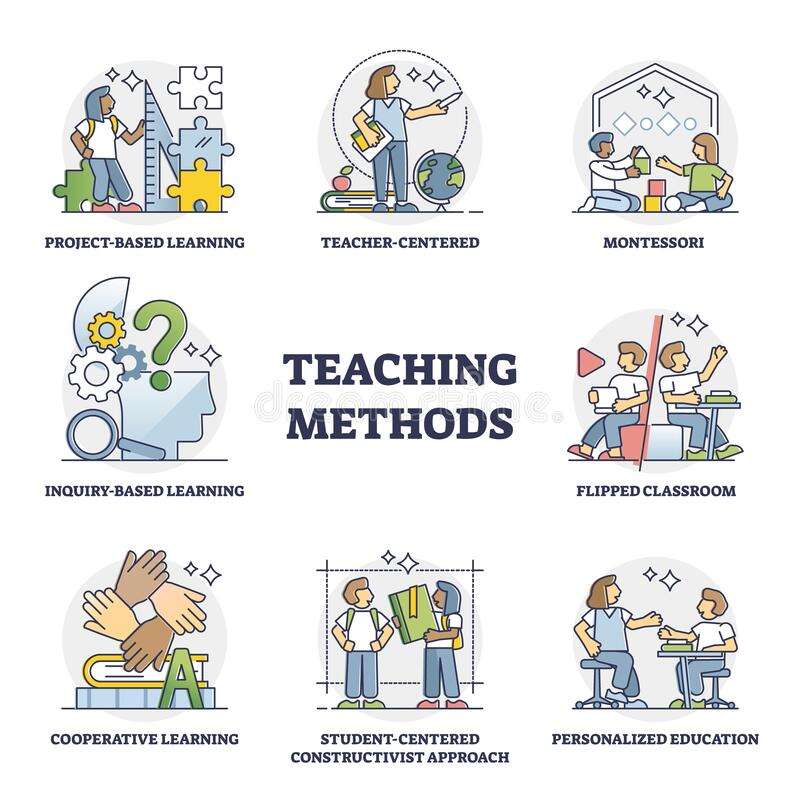
Community-based learning pods are revolutionizing education by offering a unique and dynamic learning environment. Unlike traditional schools, pods can tailor their approach to each student, fostering a love of learning and maximizing their potential. This blog explores ten powerful teaching methods that can be implemented in your learning pod: 1. Flipped Classrooms: Learning at Your Own Pace Forget the one-size-fits-all approach! Flipped classrooms empower students to learn foundational concepts at home using online resources. This frees up class time for in-depth discussions, problem-solving activities, and personalized support. 2. Game On! Engaging with Educational Games Learning doesn’t have to be a chore. Educational games tap into students’ natural love of play, using competition, rewards, and interactive elements to solidify concepts and boost engagement. 3. Putting Students in Charge: Student-Centered Learning Student-centered learning empowers students to take ownership of their education. By fostering exploration of personal interests and connecting them to broader subjects, this approach ignites curiosity and a deeper understanding. 4. Spark Curiosity: Inquiry-Based Learning Inquiry-based learning encourages critical thinking by posing open-ended questions and challenging students to find their own solutions. This approach fosters independent thought, research skills, and a love for discovery. 5. Learning by Doing: Project-Based Learning Project-based learning goes beyond textbooks. Students tackle real-world problems, developing critical thinking, collaboration, and interdisciplinary skills that will serve them throughout their lives. Problem-Based Learning: A Challenge to Conquer Similar to project-based learning, problem-based learning throws students headfirst into a challenge before any instruction begins. This sparks curiosity and encourages research as they find solutions on their own. 7. The Power of Discussion: Discussion-Based Learning Learning thrives on interaction. Discussion-based learning encourages collaboration and critical thinking as students explore topics from different perspectives. It hones communication skills and promotes independent learning. 8. Learning Through Play: Play-Based Learning for Young Minds Play isn’t just fun; it’s essential for young learners! Play-based learning allows students to develop social skills, explore their curiosity, and build a strong foundation for future academic success. 9. Service Learning: Making a Difference in the Community Service learning blends classroom learning with real-world volunteer work. By tackling community issues, students gain practical experience, develop empathy, and see how academic concepts can make a positive impact. 10. Social-Emotional Learning: Building Well-Rounded Individuals Social-emotional learning (SEL) equips students with the skills they need to navigate both academic and personal challenges. It focuses on self-awareness, emotional regulation, and relationship building, fostering well-rounded individuals prepared for future success. By incorporating these diverse teaching methods, community learning pods can create a dynamic and stimulating learning environment that caters to every student’s unique needs and learning styles. Let’s unleash the potential within each student and foster a lifelong love of learning! Frequently Asked Questions What is a flipped classroom? In a flipped classroom, students learn foundational concepts at home using online resources or other materials. Class time is then used for more in-depth discussions, problem-solving activities, and personalized support. What are the benefits of game-based learning? Educational games can make learning more engaging and interactive, helping students retain information better. They can also promote critical thinking, problem-solving, and healthy competition. How does student-centered learning work? Student-centered learning focuses on the interests and needs of each student. Teachers provide resources and guidance, but students have more autonomy over their learning journey, allowing them to explore topics that spark their curiosity. What is the difference between project-based and problem-based learning? Both methods involve students working on a real-world challenge. Project-based learning often starts with a clear goal or question, while problem-based learning throws students headfirst into a challenge before providing instruction. How can I find resources for these teaching methods? Many online resources and educational organizations offer support and guidance for implementing these teaching methods. Additionally, teacher communities and education conferences can be valuable sources of information. What are the challenges of implementing these methods? Some teaching methods may require additional planning and preparation from teachers. Additionally, creating a supportive and collaborative learning environment is crucial for success. Conclusion:Unleashing Potential and Igniting a Passion for Learning Community learning pods offer a unique opportunity to revolutionize education. By implementing these ten powerful teaching methods, you can create a dynamic and engaging learning environment that caters to each student’s individual needs and learning styles. From the personalized approach of flipped classrooms to the collaborative spirit of discussion-based learning, these methods foster a deeper understanding, critical thinking skills, and a love of learning that will stay with students throughout their lives.Remember, the ultimate goal is to empower students to take charge of their education, explore their passions, and develop the well-rounded skills they need to thrive in the real world. So, embrace the flexibility of community learning pods, unleash the potential within your students, and ignite a lifelong passion for learning together! Developed by Pranav Gorathe
Why are parents reluctant to explore homeschooling?
For many parents, homeschooling is a fascinating concept that promises flexibility, individualized attention, and control over what their child learns. However, despite its growing popularity, many parents remain hesitant to explore homeschooling as an option. Let’s explore some reasons why parents may be reluctant to homeschool their children. One of the most common reasons parents cite for not homeschooling their children is the lack of time. Many parents already lead busy lives and struggle to find time to balance work, household responsibilities, and their children’s needs. Adding homeschooling to the mix can seem overwhelming. Another reason parents may be reluctant to explore homeschooling is a lack of confidence in their teaching abilities. Parents may feel that they don’t have the necessary knowledge or skills to teach their children effectively. They may worry that their children will fall behind or not receive the same quality of education as they would in a traditional school. It is important to note that homeschooling does not require parents to be a classroom teacher or subject matter experts. The world’s best teachers teach online – and many do this for free at world-class resources such as YouTube University, Khan Academy, and www.magnetbrains.com. Many of these are mapped to the school curriculum as well! Additionally, parents can seek out support from homeschooling communities like www.aslishiksha.com and other homeschooling parents to share ideas and advice. Parenting can be challenging, and many parents crave time away from their children to pursue their own interests and hobbies. Homeschooling requires parents to spend a significant amount of time with their children, which can be overwhelming for some parents. Homeschooling does not mean nagging your kids to study. It means allowing them the freedom to learn for themselves, without getting trapped in a school classroom, listening to boring lectures from bored teachers! And homeschooling allows you to spend plenty of quality time with your children, creating a much deeper bond and stronger relationship. Homeschooling can be viewed as an unconventional choice, and some parents may worry about what others will think of their decision. They may fear that their children will be judged or stigmatized for not attending a traditional school, or that they will face criticism from friends and family. It is essential to remember that homeschooling is a legitimate and legal option for educating children. Homeschooling parents should focus on their children’s needs and what works best for their family, rather than worrying about what others may think. Another common concern among parents is that homeschooling may lead to social isolation for their children. Parents worry that their children will miss out on socialization opportunities and not develop the social skills necessary to thrive in the world. However, homeschooling does not have to be a solitary experience – they aren’t trapped at home, and get to learn from real-life experiences all the time. Life is full of teaching moments – and homeschooling allows you to make the most of these, by encouraging them to interact with people of different ages and backgrounds, rather than only the homogenous group of kids of the same age that they are exposed to in a school setting. Homeschooling provides children with more flexibility to pursue extracurricular activities and hobbies that may not be available in a traditional school setting.
